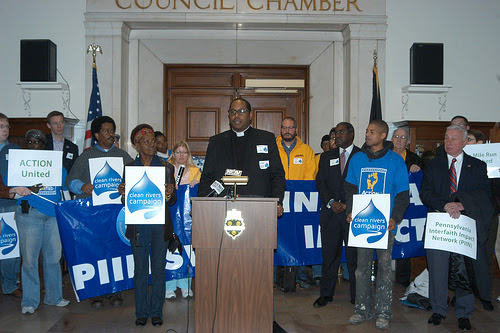Pittsburgh is about to make the largest public investment in its history. Like hundreds of cities across the country, the Pittsburgh Region’s sanitary authority, ALCOSAN is under a consent decree with the Environmental Protection Agency (EPA) because it is not in compliance with the Clean Water Act, meaning that when it rains, raw sewage from the city’s overburdened sewer system over flows and pollutes the area’s rivers. ALCOSAN is under a mandate from the EPA to fix the problem, which gives Pittsburgh a tremendous opportunity to make real, long lasting changes.
“I am an outspoken advocate of Pittsburgh’s ability to become a leader of green initiatives and infrastructure in dealing with our stormwater overflow. We need to get this right because what we decide today will shape our future for the next 100 years.”
– Mayor Bill Peduto, July 2013

The Clean Rivers Campaign is leading the way. This coalition of organizations led by Pittsburgh UNITED and including Clean Water Action and Action United was launched as an advocacy and education campaign almost three years ago that was tasked with informing ordinary people and elected officials about the opportunity to create a sustainable and vibrant Pittsburgh by investing in green infrastructure to repair the City’s sewer system. Together, the partner organizations knocked on more than 40,000 doors, hosted speaker series on the benefits of green solutions, and met with elected officials from Pittsburgh and from other municipalities across the region to discuss how investing in green solutions can bring economic, social, and environmental benefits to cities and the people who live there.
Emily Alvarado, age 32, who has worked as the interim director of the Clean Rivers Campaign for the past year explained, “Not many people think about sewage…but when you show people that this sewer investment will be the largest ever public investment in our region’s history (over 2 billion dollars), they agree that we must maximize the benefits of that investment to clean our water and rebuild communities. The Clean Rivers Campaign has been key in creating a public dialogue about our sewer fix and advocating for green solutions as a sustainable approach to our water infrastructure needs that provides many community benefits.”
Using green solutions means investing in infrastructure that uses natural processes to manage stormwater. There are a whole array of strategies to help absorb water into the ground rather than having it run straight into the sewer system, such as rain gardens, bioswales, properly maintained and planted trees, permeable pavements, and green roofs. However, few cities have water management systems that use these techniques. Tom Hoffman, the Western Pennsylvania Director at Clean Water Action, explained that when it rains in Pittsburgh currently the water runs off of the roofs, the parking lots and the streets and the sidewalks and it goes into storm sewers. “Unfortunately, like many cities our ‘storm sewers’ and our ‘sewers sewers’ are the same thing,” meaning that storm water runoff ultimately flows into the same sewers used for raw sewage. This is called a Combined Sewer System (CSS). During heavy rainfalls, the amount of water in the CSS exceeds the system’s capacity, and is ultimately discharged directly into rivers, spilling raw sewage into natural water bodies to relieve overburdened sewers.
Green infrastructure offers a more sustainable and environmentally friendly alternative. One of the most vocal advocates for these types of solutions in the City of Pittsburgh has been Pittsburgh Mayor Bill Peduto. When the EPA ruled that ALCOSAN’s current plan to fix the sewer system using gray infrastructure was deficient, Alvarado explained that Mayor Peduto responded passionately about the city’s opportunity to use green infrastructure for the City’s sewer fix.

Mayors want the best for their cities, which makes green infrastructure investments an even more positive choice since the benefits go beyond just the environment. Because the sewer repair will be funded by ratepayer increases, it is important that local people can see improvements in their communities. Green solutions will produce more green spaces in communities, increase property values and decrease crime, as well as create good jobs.
“Our vision is to use this investment as one that both solves our water quality problems and meets many community needs at the same time,” said Alvarado. For her, some of the most exciting aspects of this work have been the moments where the strength of civic engagement shines through. “By doing education and organizing work we have brought thousands of ordinary rate payers to meetings and public hearings. Some of these people have never been involved in community advocacy before. But they understand that we must work together to ensure that this massive public investment creates healthy communities and economic opportunities for generations to come. And they get that we have the chance to transform this investment to rebuild the Pittsburgh region in an equitable and sustainable way.”
Being at the forefront of cities making a green-first sewer fix isn’t always easy. While there is research from around the country, Pittsburgh needs more local data to demonstrate the kinds of impacts created by investments in green infrastructure. Using ioby, the Clean River Campaign has begun to generate the revenue to get the local data they need to show the sanitary authority that green solutions are really a cost effective way of maximizing benefits. Alvarado explained, “The technical analysis resulting from this study will show the potential for green infrastructure, paired with right sized gray infrastructure to address our region’s water quality problems. The study will provide a data-driven, technical framework to assist the region’s decision makers, in making informed decisions about this infrastructure investment.” They can continue to conduct this important research with your support.


